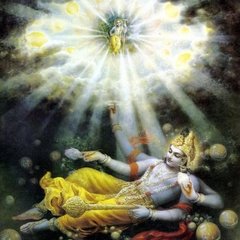Search the Community
Showing results for tags 'samadhi'.
Found 6 results
-

How would you counter this hypothesis to the ‘Enlightenment’ idea?
galen_burnett posted a topic in General Discussion
So there is an argument that happiness only exists if it has suffering as a reference point. This is a conclusion that can be arrived at if you consider that the idea of everything existing in pairs and as opposites—the idea of Yin and Yang—is fundamental to existence; in this argument, happiness and suffering (I’ll say joy and pain hereafter as they’re shorter words) are not considered to be exceptions to this rule of Yin-Yang opposites, but rather are just another manifestation of Yin and Yang—albeit the most fundamental manifestation of Yin-Yang, as what experience could ever there be in Duality without shades of joy and pain? The argument is that joy can never be separated from pain because joy and pain define each other; they are a pair of opposites, like North and South; they refer to each other to give themselves meaning; without one the other ceases to exist. If all you ever saw was the colour blue then before long you would forget entirely what the other colours were, and the idea of colours, along with the colour blue itself, would then cease to be; considering, say, the greatest joy to be the colour blue in this analogy, the greatest pain as red, and all the degrees of pain and joy in-between—‘rather pleased’, ‘fine’, ‘bit off today’, ‘pretty annoyed’, etc.—being represented by the other colours. [*I know red and blue aren’t directly opposite each other on the colour-wheel, I guess cyan and orange are really, but it suffices for this post.] What’s more, in Eastern thought itself it’s considered that opposites give rise to each other in rotation: mess gives birth to cleanliness, which then becomes messy again; night to day, to night; pressure to expansion, closing into pressure once more; and so on. In this argument it is assumed that joy and pain behave in the same way: the most perfect heaven can become a hell of tedium and constriction if you stay there for too long; and the most violent hell can be inured to and got used to with enough time, until it even becomes a place of amusement and intrigue. Also, in this argument it is assumed that any and all levels of joy—even the very highest, most ultimate, degree of it imaginable—are still just ‘joy’, that all degrees of joy are as valid as each other; there is no splitting of hairs in this argument regarding the possibility of some greatest happiness existing ‘outside the bounds’ of ‘joy’—such a notion doesn’t make any sense from this point of view. I should note here that in this argument while all degrees of joy are considered as ‘valid’, it is accepted that not all beings will gain the same degree of joy from the same stimulus: a TV soap-opera may delight some people while be anathema to others, and meditation may be enormously relaxing and revitalising for some while incredible boring and dull for others; but this point is universally agreed upon by most, I think. There is the further matter of how ‘refined’ each degree of joy (or pain) is, and this actually comes relatively close to agreeing with the concept of an ultimate happiness actually, but stops short enough to still disagree with it considerably—but it is a tangent for another time. The notion of attainment of ‘perpetual-bliss’ is common throughout Eastern spiritual-practices and philosophy: it can be found in yoga, in Buddhist philosophy, and in Daoism (the attainment of Dao), going by various names (I’ve cited some of them in the tags of this post). It is the notion that, with diligence etc. , a person can transcend the plane of Duality and merge with the Non-Dual, whereat awaits perfect bliss and harmony for them, which they may abide in forever after. If we accept the argument that joy and pain are essentially dualistic opposites, then how can we sever them, throw out one, keep the other and then escape into Non-Duality with it? How can we smuggle a dualistic entity—i.e. joy—into the realm of Non-Duality? Wouldn’t Non-Duality be devoid of all experience whatsoever—blanker than blank—as all experiences in existence, including all forms of joy and pain, belong to Duality? even ‘experience’ itself can be thought of as being a dualistic opposite to ‘non-experience’ (though non-experience is impossible to comprehend). Rather than, say, Sahasraha (see Tantric yoga stuff) being an experience of the Non-Dual, isn’t it more apt to consider it as an experience of boundlessness, of formlessness, of unity, of mergence, of the infinite? which qualities are still within the realm of Duality, and therefore the Sahasraha experience itself could still be considered as a dualistic experience. In addition, if the happiness of Nirvana—said to be beyond the ‘illusory’ joys of Samsara—resides in the incomprehensible realm of the Non-Dual, then how can anything—including ‘illusory’ joys of Samsara—be compared to it? If it is beyond all things, how can those who tell of it liken it to anything at all, including to ‘illusory’ joy? How can they say “you know what ‘nice feelings’ are, right? Well Nirvana is ‘nice feelings’ times 100!” when Nirvana is supposed to be completely unlike anything that can be experienced in Duality, including pleasure and pain; so surely, then, there is no way to say that Nirvana is ‘nice’, as ‘nice’ is ‘dual’ and Nirvana ‘non-dual’; and yet, are we not in Eastern spiritual-practices encouraged to seek Nirvana for it being supposedly ‘nice’? So how would you counter this argument and uphold the notion of attainable ‘perpetual-bliss’? Have you met anyone who claimed to have attained it? If so, what made you believe them? If that person was indeed sincere in their claim to that experience, how did that person know themselves that they were not just experiencing a very long ‘high’? Also, how could that person have been operating in Duality if they had entered Non-Duality? If you believe in it after having read or heard about it, what that you have read or heard counters this argument? If both the experience itself and any attempt to explain the experience are beyond logic—due to ‘logic’ being tethered to Duality, and ‘ultimate attainment’ residing beyond Duality in Non-Duality—then how do you know about it in the first place and how are you able to talk about it or think about it—as knowledge, thought and speech all belong to the great despot of Duality—? If it is an intuition of yours that it is real, are you really willing to surrender your whole life in an attempt to attain something based on a gut-feeling? If you deduce its existence by extrapolation of your own life experiences—spiritual ones included—how do you do so?: what about your own experiences hints at the possible attainment of ‘perpetual-bliss’? There is a further argument against the notion of ‘perpetual-bliss’ which concerns itself with permanence-impermanence and with beginnings and ends and ‘ultimate attainments’, and though the argument in this post touches on this—through considering how opposites continually roll and transform into one another, and through questioning the true nature of an Enlightenment experience such as Sahasraha a couple paragraphs above—it’s divergent enough to leave it out here. As an aside, I am not debating here that great spiritual-experiences exist—they certainly do—; neither am I debating the immortality of the soul nor of consciousness—it certainly is—; neither am I denying enlightenment when considered as the notion of a progression through higher and higher levels of awareness, ability and intelligence; this is just an argument against the idea of the existence and attainment of ‘perpetual-bliss’.- 568 replies
-
- 3
-

-
- enlightenment
- samadhi
-
(and 8 more)
Tagged with:
-

What technique is used to achieve siddhis of super memory and intelligence
Asher Topaz posted a topic in Hindu Discussion
So I have been studying and reading about yoga and all practices involved in yoga. From my understanding its really a complicated science. I recently read about siddhis and how one can use samayama(dharana, dhyana, samadhi) to achieve siddhis based on the object they use for meditation. I was wondering how one can achieve the siddhis of supermemory and intelligence. My research led me to mantra from sarswati as one method that is used by yogis. I was wondering if there is an object one can use to perform samayama to achieve this siddhis like how we have samayama on the strength of an elephant to achieve supernormal strength. Or if yoga and pranayama practices can also give the siddhis of supermemory and intelligence. Thanks. -
I started reading taoist yoga and i must say all the nei dan information dont look like instructions to me. They look like biographical information of the alchemical changes of the energy body as one cultivates towards samadhi. There are too much steps and processes to be aware of that I believe alchemy infromation was more like sign posts that your on the right track rather than steps to actually follow. I mean there are easier ways like anapanasati and skeleton visualization from the buddha or samatha(concentration) practices in general. Instead of the risky practice that is alchemy. And yes you can not achieve samadhi without alchemical changes happening inside you. Else it would be false samadhi. Nan Hua Chin said that samadhi without change in your body is a false teaching that has infected buddhism especially zen. He encourages people to learn about alchemy only to use it as a referral that they are on the right track rather than an instruction manual. His book Tao & Longevity: Mind-Body Transformation shows how alchemical changes happen in the body using practices like anapanasati from the buddha. He says its based on the rule of the dao that extreme yin gives birth to yang. So the stillness from anapanasati where at some point you slow down to the point of having your breath, pulse and thoughts stop(hsi), gives birth to the yang chi being born. No need for all the alchemical jargon just slow down and become still and the internal alchemy will take place. its like our bodies mimicking creation. Where from wuji came taiji and from taiji came yang chi of heaven. The secret of immortality. It has also been said in yoga that physical immortals are in samadhi 24/7 hence they are constantly in touch with the yang qi of heaven. So if alchemy is just another way to samadhi or wuji why do Daoist treat it like its some super secret when there are even safer and less cumbersome ways of getting to samadhi. After all the emptiness is called nirvikalpa samadhi in other traditions.
-

Two paths to cultivation. Consciousness path(dhyana-samadhi) and esoteric path(energy,qi channels)
Asher Topaz posted a topic in Buddhist Discussion
I am a beginner who has been reading lots of books trying to create a scheduled practice. I have looked at Buddhism, Taoism, 8 limbs of yoga, kundalini yoga and more techniques. It seems they all start with creating an energy body by purifying qi channels. And each body is accompanied by a mental state called dhyana/samadhi. Like how monkey mind comes with our physical body. I believe cultivation has two paths. Either u cultivate dhyana by directly manipulating QI channels as they do in esoteric schools like taoism, tibettan buddhism or kundalini yoga or u manipulate consciousness like Buddha who achieved all 8 dhyana before enlightenment. Like taoist have Jing -Qi-Shen-emptiness-tao. Which starts with embryonic breathing then microcosmic circulation then macrocosmic circulation. Then brain marrow washing. Embryonic breathing is like pranayama in yoga. They aim towards achieving breath cessation where d breath stops. That's what pranayama actually means. All the different types of pranayama the main goal is balancing the Ida and pingala so the kundalini can rise through the sushumna channel in the spine. In taoism as u practice embryonic breathing at some point ur breath slows down and the Dan tien and qi point starts breathing. The wind qi then ignites yang chi to rise through the tu mai and start the microcosmic circulation. No different from kundalini yoga. The bliss in dhyana is the kundalini circulating and purifying our qi channels turning jing to qi. In Buddhism specifically those that practice dhyana all this things happen automatically then u enter first dhyana. First and second dhyana jing turns to qi, by third dhyana qi starts turning to Shen which is why u no longer feel raw bliss from jing turning to qi. And 4th dhyana is shen to emptiness which is equanimity and one pointedness.. And emptiness has levels. In Buddhism we have infinite space, consciousness, nothingness and neither perception no perception. Each dhyana comes with an immortal body. In taoism the first and second dhyana is earth immortal then third dhyana is spirit immortal then fourth dhyana is celestial immortal. In buddhism this are called deva bodies Which is why dhyana samadhi can gives powers just like energy cultivators. The powers are a result of our subtle bodies made up of higher realm energy interacting with our lower realm. Which we see in true internal martial arts that can channel the power of their qi body through thier physical body. So siddhis in patanjali sutra and visuddhimagga.hence why they require u get to the 4th dhyana to cultivate powers. So if u look closely all spiritual practices from internal martial arts to yoga asanas to pranayama and qi gong to neigong to Nyasa yoga and chakra visualization to tummo and kundalini yoga or vjaryana or Tibetan Buddhism it tantara or sexual cultivation and so many others are tools to open qi channels and purify the qi and achieve samadhi and build qi bodies or deva bodies. To ignite the kundalini and purify the body. However it seems people took the energy occurences as you cultivate samadhi and turned them into goals in themselves. Like pranayama khumbakka which is embryonic breathing from when breath slows down in dhyana to kundalini rising through the spine and opening chakras as u climb dhyana stages. To micro cosmic circulation which is the first 2 dhyana to macrocosmic which us the last two dhyana or bliss in sexual cultivation which happens in dhyana. So there are two paths to cultivating subtle bodies. The esoteric path of qi manipulation or consciousness path of dhyana-samadhi. My practise is dhyana cultivation using anapana,skeleton visualization and later elemental kasinas I shy away from esoteric practices as it can be dangerous without a true teacher. What do u guys think? -

Ramana Maharshi's distinction between samadhi and laya
blackfence posted a topic in Hindu Discussion
A tricky and very interesting distinction is present in Maharshi's work between samadhi -- a profound state of concentrated absorption where the distinction between "I" and "not I" breaks down -- and laya, which is also absorption... but in which ignorance does not break down. Both are states or profound peace. Samadhi can easily turn into laya, Maharshi says, so seekers should be warned. Elsewhere, however, he says that states of peace need not be interrupted. So which is it? Well, the answer lies in where the seeker is along the path. The mind has to be turned inward and concentrated, and various methods that produce laya can result in this; but the ultimate samadhi is not one that turns into laya, but is that which is seen when even laya is questioned, self-inquired into, or surrendered.-
- samadhi
- enlightenment
-
(and 1 more)
Tagged with:
-
Diagram found on the albigen network. It's characterized as "a synopsis of states of consciousness and realization", and is aligned with Ramana Maharshi's commentary on the experience of Samadhi. Thought I'd share, along with some pertinent commentary by, Sri Sadhu Om. Mind in Sleep Kevala Nirvikalpa Samadhi Sahaja Nirvikalpa Samadhi 1. Mind alive 1. Mind alive 1. Mind dead 2. Sunk in oblivion 2. Sunk in Light 2. Resolved into the Self 3. Like a bucket tied to a 3. Like a river discharged rope and left lying in the into the ocean and its water in a well identity lost. 4. to be drawn out by the 4. A river cannot be other end of the rope redirected from the ocean
- 7 replies
-
- 2
-

-
- nirvikalpa
- mind
-
(and 2 more)
Tagged with:



